

Parosteal osteosarcoma arises from periosseous tissues adjacent to the cortex. It is usually considered as an osteosarcoma variant, which must be differentiated from the intracortical and periosteal variants of osteosarcoma.
Parosteal osteosarcoma is slow-growing and late to metastasize; accordingly, it carries a better prognosis than other variants of osteosarcoma. It is generally a low-grade highly differentiated tumor but has the potential to turn into a high-grade poorly differentiated tumor, even though the incidence of such conversion is very low. Often, the tumor is palpable because of the large amount of homogeneous lobulated new bone outside the bone shell extending into the soft tissue. It is juxtacortical in position and densely ossified.
Parosteal osteosarcomas make up 4% of all osteosarcomas. There is no sex predilection, though some studies suggest female preponderance. More than half of the tumors arise from the posterior aspect of the distal femur in the metaphysis. The other common sites are the proximal tibia and the humerus. Rare examples of involvement of acral skeleton and craniofacial bones are also described in the literature.
Chemotherapy and radiotherapy generally are not very effective in treating parosteal osteosarcomas. Wide resection with limb salvage is the surgical treatment of choice. Gene therapy is the future for treating such cancers in the orthopedic setting; however, it is still in its infancy, and considerable research and development will be required before it can be widely implemented.
NextParosteal osteosarcoma occurs in the periosseous tissues. It has not been described to arise from sites other than the major tubular bones. The most commonly affected sites, in descending order, are the distal femur (typically the posterior surface), the proximal humerus, the proximal femur, the proximal tibia, and the proximal ulna. By contrast, the proximal tibia is the most common site for periosteal osteosarcoma.
Parosteal osteosarcoma has a slow rate of development; however, it eventually destroys the cortex and involves the medulla at later stages. It is a well-differentiated and late-metastasizing tumor and thus has a better prognosis.
The exact etiology of osteosarcoma is still unknown. However, numerous chemical agents, including methylcholanthrene, beryllium oxide, and zinc beryllium silicate, have been implicated in animal models. Other causes include radiation, viruses and heredity.
Parosteal osteosarcoma usually occurs in older age with a peak in the third and fourth decades of life, with no sex predilection. It commonly presents as a slow-growing painless lump in the posterior aspect of the distal femur; however, it can be painful as well. The pain may be dull and aching in nature. Rarely, parosteal osteosarcoma can present with restriction of joint movement when it occurs close to the joint. The duration of symptoms may range from 1 month to 2 years before the diagnosis.
Orthogonal views of the affected long bone with the joints above and below should be obtained, preferably in conjunction with full-length radiographs of the bones. Because parosteal osteosarcoma is a bone-forming tumor, the lesions will be radiopaque on radiography. The degree of opacity depends on the maturity and quantity of the osseous component (see the image below).
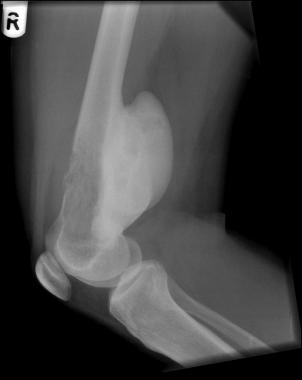 Plain radiograph showing the increased opacity in the lesion (parosteal osteosarcoma) in the posterior aspect of distal femur which is the classical site.
Plain radiograph showing the increased opacity in the lesion (parosteal osteosarcoma) in the posterior aspect of distal femur which is the classical site.
Commonly, peripheral areas appear cloudy and indistinct, indicating that they are less mature. However, there is no correlation between radiopacity and histologic grade: even a lesion that is heavily radiopaque on radiographs and has sharply demarcated margins can be a high-grade poorly differentiated tumor. A radiotranslucent line may be seen between the cortex and the tumor, indicating the presence of fibrous and cartilaginous tissues. The tumor can present late; thus, cortical erosion and medullary involvement may be seen at presentation.
Computed tomography (CT) may be employed for local staging (see the images below), but magnetic resonance imaging (MRI) is preferred.
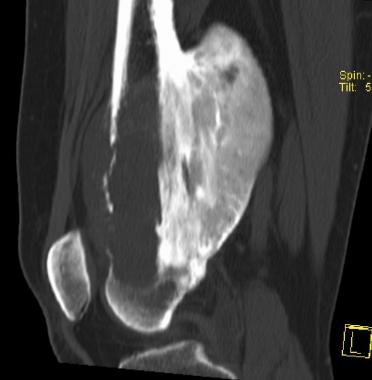 CT Sagittal Reconstruction of the same lesion as in plain radiographic image shown above.
CT Sagittal Reconstruction of the same lesion as in plain radiographic image shown above.
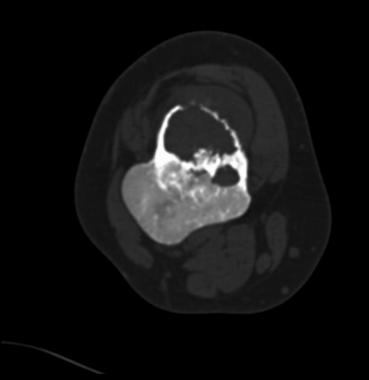 CT axial section of the same lesion as in image above.
CT axial section of the same lesion as in image above.
MRI is very useful for evaluating intramedullary involvement, especially in late-presenting cases. It is also useful for determining joint involvement, assessing tumor encroachment on major neurovascular tissues, and examining the surrounding reactive zone for the purposes of preoperative planning (see the images below). To exclude rare skip lesions in dedifferentiated parosteal osteosarcoma, MRI should cover the whole bone.
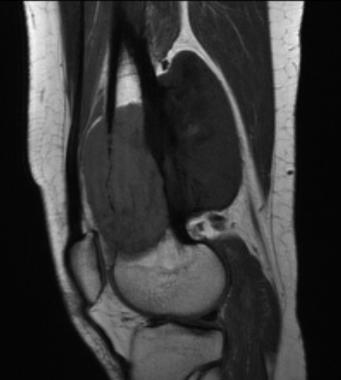 T1 weighted MRI scan of the same lesion as in plain radiographic image shown above.
T1 weighted MRI scan of the same lesion as in plain radiographic image shown above.
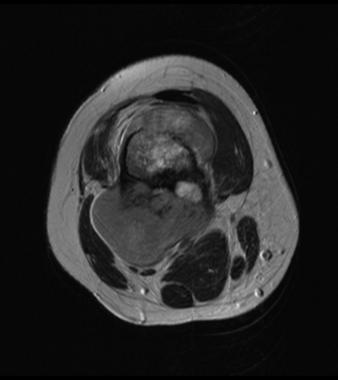 T2 weighted MRI axial section of the same lesion shown in image above.
T2 weighted MRI axial section of the same lesion shown in image above.
Routine blood tests are performed to assess the patient’s general medical condition and assessment of fitness for anesthesia.
Angiography was more commonly used before the advent of CT and MRI scanning, when it was valuable for defining the relation of the tumor to the major vascular structures, particularly in the popliteal and axillary regions.
Bone scanning shows an area of dense uptake within the lesion. It is useful for identifying metastasis.
Core biopsy may be done with Islam needles to confirm the diagnosis. If a sufficient sample cannot be obtained, open biopsy may be performed. The following basic principles of bone biopsy should be adhered to:
The surgical specimen shows a hard matrix-producing tumor arising from the underlying cortex of the bone. Microscopically, parosteal osteosarcoma consists of well-formed bone trabeculae in a hypocellular spindle-cell stroma.
The bone trabeculae are arranged in a parallel fashion. Spindle cells usually show minimal atypia, though in approximately 20% of cases the stroma is more cellular, with moderate cytologic atypia. Mitotic figures are rare. Approximately 50% of cases show cartilaginous differentiation in the form of either cartilaginous nodules or cartilaginous cap. Marrow involvement and cytologic atypia do not predict a worse outcome.
Dedifferentiation is seen in approximately 15% of parosteal osteosarcomas, either at the time of the original tumor or, more often, at the time of recurrence. Dedifferentiated parosteal osteosarcomas carry a worse prognosis, comparable to that noted with the conventional osteosarcomas.
Chemotherapy and radiotherapy are not very effective in parosteal osteosarcomas. If the tumor specimen is of a high histologic grade, then postoperative chemotherapy is usually advised.
Because parosteal osteosarcoma can dedifferentiate and metastasize and can cause local infiltration and destruction, its presence is an indication for treatment. Wide resection with limb salvage is the surgical treatment of choice for parosteal osteosarcoma, in view of the typically low grade of the tumor and the low rate of local recurrence. Amputation is rarely indicated. The only relative contraindication for surgical treatment in parosteal osteosarcoma is the presence of multiple metastases in a patient whose general condition is poor.
In planning the wide excision, it is necessary to obtain a clear picture of the extent of the tumor. Various imaging techniques are employed. In cases involving limb salvage and custom-made prosthesis replacement, the measurements are made by means of full-length radiographs, and a hinged prosthesis is fabricated according to the individual patient’s requirements.
Routine blood tests and various investigations are performed to rule out secondary metastasis. The patient’s general condition is assessed with respect to his or her fitness for anesthesia. The patient must be completely informed regarding the procedure; if needed, a tumor counselor should be involved.
Because the tumor is extracortical and is usually present in the posterior aspect of the distal femur, the important neurovascular structures within the fibrofatty tissue must be carefully dissected and preserved. Wide excision should be performed in accordance with preoperative planning on the basis of the measurements in the images. In rare cases, when there is doubt regarding the extent of the tumor at the time of surgery, tetracycline labeling may be used to determine the adequacy of the surgical margins.
Routine mobilization and physiotherapy are provided as appropriate for a custom-made prosthetic replacement. The main postoperative workup involves histopathologic grading of the lesion and assessment of the adequacy of the surgical margins. If the tumor turns out to be a high-grade lesion, postoperative chemotherapy must be considered. Inadequate surgical margins are associated with a high incidence of local recurrence; consequently, postoperative chemotherapy or radiotherapy may be considered in such instances.
Potential complications of tumor resection include the following:
Because parosteal osteosarcoma is typically a low-grade tumor, it carries the best prognosis of all the osteosarcomas. For low-grade lesions, complete resection ensures cure. If high-grade areas are present in the lesion, the prognosis then approaches that of conventional high-grade osteosarcomas, and the patient requires chemotherapy in addition to surgical wide excision.
Routine follow-up is needed to rule out local recurrence or the appearance of metastasis, even though these are rare in parosteal osteosarcoma.
Copyright © www.orthopaedics.win Bone Health All Rights Reserved